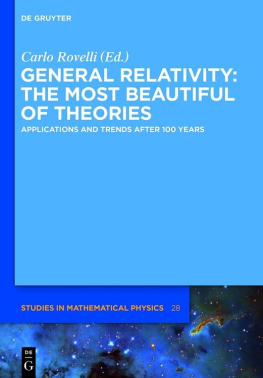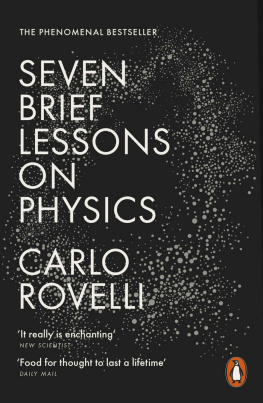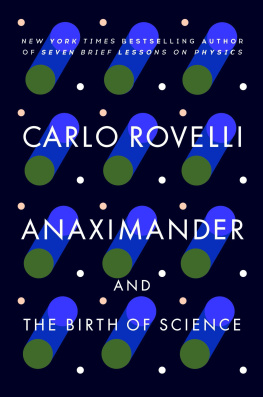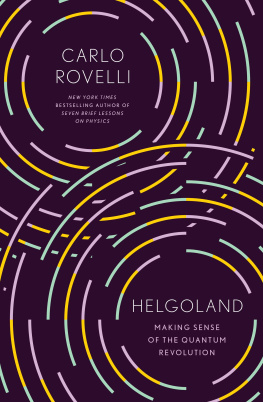
RIVERHEAD BOOKS
An imprint of Penguin Random House LLC
375 Hudson Street
New York, New York 10014

First American edition published by Riverhead Books 2017
Copyright 2014 by Raffaello Cortina Editore SpA
Translation copyright 2016 by Simon Carnell and Erica Segre
Originally published in Italian under the title La realt non come ci appare by Rafaello Cortina, Milan
English translation published in Great Britain by Allen Lane, an imprint of Penguin Random House UK
Penguin supports copyright. Copyright fuels creativity, encourages diverse voices, promotes free speech, and creates a vibrant culture. Thank you for buying an authorized edition of this book and for complying with copyright laws by not reproducing, scanning, or distributing any part of it in any form without permission. You are supporting writers and allowing Penguin to continue to publish books for every reader.
Ebook ISBN: 9780735213944
Library of Congress Cataloging-in-Publication Data
Names: Rovelli, Carlo, 1956- author. | Carnell, Simon, 1962- translator. | Segre, Erica, translator.
Title: Reality is not what it seems : the journey to quantum gravity / Carlo Rovelli ; translated by Simon Carnell and Erica Segre.
Other titles: Realt non come ci appare. English
Description: First American edition. | New York, New York : Riverhead Books, an imprint of Penguin Random House LLC, 2017. | Originally published in Italian under the title: La Realt non come ci appare. | English translation published in Great Britain by Allen Lane, an imprint of Penguin Random House UK. | Includes bibliographical references and index.
Identifiers: LCCN 2016036293 | ISBN 9780735213920 | ISBN 0735213925
Subjects: LCSH: Quantum gravity.
Classification: LCC QC178 .R69313 2017 | DDC 530.14/3dc23
LC record available at https://lccn.loc.gov/2016036293
p. cm.
Version_1
CONTENTS
PREFACE
During my entire research life, friends and curious people have asked me to explain what was going on in quantum gravity research. How was it possible to study new ways of thinking about space and time? Over and over again I have been asked to write a popular account of this research. While books on cosmology or string theory abound, a book describing the research on the quantum nature of space and time, and on loop quantum gravity in particular, did not yet exist. I have long hesitated, because I wanted to concentrate on research. Some years ago, after completing my technical book on the subject, I felt that the collective work of many scientists had moved the topic to a stage mature enough for a popular book. The landscape we are exploring was enchanting: why keep it hidden? But I still delayed the project, because I could not see the book in my head. How to explain a world without space and time? One night in 2012, during a long solitary drive from Italy to France, I realized that the only way to explain in a comprehensible manner the ongoing modifications of the notions of space and time was to tell the story from the beginning: starting from Democritus, all the way through to the quanta of space. After all, this is how I understand the story. I began to design the entire book in my mind while driving, and got increasingly excited, until I heard a police cars siren telling me to pull over: I was driving far above the speed limit. The Italian policeman asked me politely if I was crazy to drive at that speed. I explained that I had just found the idea Id been seeking for so long; the policeman let me go without a ticket, and wished me good luck with the book. This is that book.
This book was written and first published in Italian at the beginning of 2014. Shortly after, I wrote a few articles on fundamental physics for an Italian newspaper. A prestigious Italian publisher, Adelphi, asked me for an extended version of these articles to appear as a small booklet. This is the origin of the short book Seven Brief Lessons on Physics, which to my immense surprise has become an international best seller and has opened a beautiful channel of communication between me and so many wonderful readers all over the world. The Seven Lessons were thus written after this book, and to some extent they are a synthesis of some of the topics you find here. If you have read Seven Brief Lessons on Physics and want to know more, to journey deeper into the strange world that book sketched, here you can find more.
While the account of established physics I give here is presented from the peculiar perspective as I understand it, it is largely uncontroversial. However, the part of this book that describes current research in quantum gravity is my own personal understanding of the state of the art. This is the region at the boundary between what we have understood and what we do not yet understand, and is still far from achieving consensus. Some of my physicist colleagues will agree with what I write here; others wont. This is true for all presentations of ongoing research at the frontiers of knowledge, but I prefer to state it up front and clearly. This is not a book about certainties; it is a book about the adventure of moving toward the unknown.
As a whole, this is a travel book describing one of the most spectacular journeys that humanity has taken: a journey out of our limited and parochial views of reality, toward an increasingly vast understanding of the structure of things. A magic journey out of our commonsense view of things, far from complete.
Carlo Rovelli
Marseille, May 4, 2016
INTRODUCTION
WALKING ALONG THE SHORE
W e are obsessed with ourselves. We study our history, our psychology, our philosophy, our gods. Much of our knowledge revolves around ourselves, as if we were the most important thing in the universe. I think I like physics because it opens a window through which we can see further. It gives me the sense of fresh air entering the house.
What we see out there through the window is constantly surprising us. We have learned a great deal about the universe. In the course of the centuries, we have come to realize just how very many wrong ideas we had. We thought that Earth was flat, and that it was the still center of our world. That the universe was small, and unchanging. We believed that humans were a breed apart, without kinship to the other animals. We have learned of the existence of quarks, black holes, particles of light, waves of space, and the extraordinary molecular structures in every cell of our bodies. The human race is like a growing child who discovers with amazement that the world consists not just of his bedroom and playground, but that it is vast, and that there are a thousand things to discover, and innumerable ideas quite different from those with which he began. The universe is multiform and boundless, and we continue to stumble upon new aspects of it. The more we learn about the world, the more we are amazed by its variety, beauty, and simplicity.
But the more we discover, the more we understand that what we dont yet know is greater than what we know. The more powerful our telescopes, the more strange and unexpected are the heavens we see. The closer we look at the minute detail of matter, the more we discover of its profound structure. Today we see almost to the Big Bang, the great explosion from which, fourteen billion years ago, all the galaxies were bornbut we have already begun to glimpse something beyond the Big Bang. We have learned that space is curved but already foresee that this same space is woven from vibrating quantum grains.


















